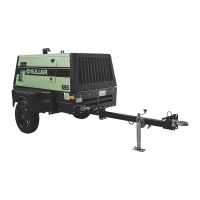Section 5
MAINTENANCE
28
Figure 5 --- 5 Typical E --- Z Lube Axle
point the engine should be at ratedspeed. Ifnec-
essary, to raise or lower the speed, lengthen or
shorten the rod respectively.
OPERATING ADJUSTMENTS
The firststep isto start the compressor accordingto
the instr uc tions in S ec tion 4 , S ubsequent S tar t --- up.
Allow the engine to operate until it reaches the nor-
mal operating temperature. Open the service valve
until the engine speed increases to, or close to, the
maximum specified operating speed.
BEARING LUBRICATION
Ref er to Figur e 5 --- 5 . Pr oper l ubr ic ation is essential
to the proper functioning and reliability of your por-
table compressor axle. Wheel bearings should be
lubricated at least once every 12 months, or more
frequently to help insure proper performance. Use
wheel bearing grease that conforms to military
specification MIL---G---10924 or a high temperature
wheel bearinggrease such aslithium complexNLGI
Consistency #2.
If your axle is equipped with the E---Z Lube feature,
the bearings can be periodically lubricated without
removing the hubs from the axle. This feature con-
sists of axle spindles that havebeen specially drilled
and fitted with a grease zerk in their ends. When
grease is pumped into the zerk, it is channeled to
the inner bearing and then flows back to the outer
bearing and eventually back out of the grease cap
hol d ( s ee Figur e 5 --- 5 ) . The pr oc edur e is a s f ol l ows:
1. Remove the rubber plug from the end of the
grease cap.
2. With a standard grease gun filled with a quality
wheel bearing grease, place the gun onto the
grease zerk located in the end of the spindle.
Make sure the grease gun nozzle is fully en-
gaged on the fitting.
3. Pump grease into the zerk. The old, displaced
grease willbegin toflowback outthe caparound
the grease gun nozzle.
4. When the new, clean grease is observed, remove
thegrease gun, wipeoffanyexcess, andreplace
the rubber plug in the cap.
5.11 TROUBLESHOOTING
The following Troubleshooting Chart is based upon
the data obtained both from testing at the factory
and from applied situations in the field. It contains
symptoms and usual causes for the described
problems, however
DO NOT
assume that these are
the only problems that may occur. All available data
concerning the trouble should be systematically
analyzed before undertaking any repairs or compo-
nent replacement procedures.
A detailed visual inspection is worth performing for
almost all problems. Doing so may prevent unnec-
essary additional damage to the compressor.
Always remember to:
1. Check for loose wiring.
2. Check for damaged piping.
3. Check for parts damaged by heat or an electrical
short circuit,usually apparent bydiscoloration or
a burnt odor.

